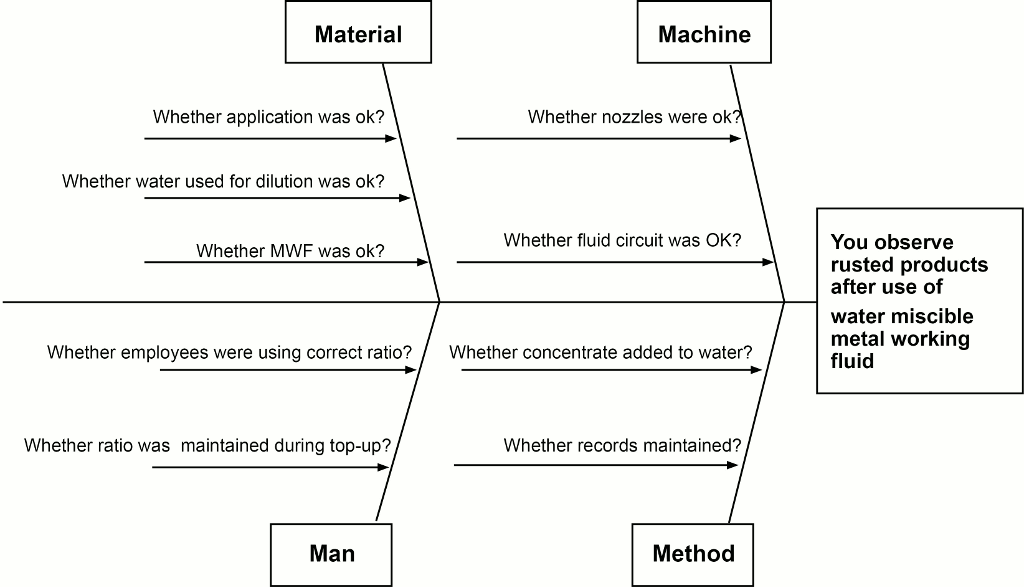You observe rusted products after use of water miscible metal working fluid
 It all started with our sales team receiving a call from one of the customers complaining about our metal working fluid (MWF). Our MWF was being used to produce mild steel (MS) square pipes. The sales person went to the customer’s site and sent us this picture, showing components with clear rusting.
It all started with our sales team receiving a call from one of the customers complaining about our metal working fluid (MWF). Our MWF was being used to produce mild steel (MS) square pipes. The sales person went to the customer’s site and sent us this picture, showing components with clear rusting.
Obviously something was wrong. One of the expected functions of MWF is that the components should be protected against rust, which is not possible if plain water was used. We asked for sample of the undiluted MWF from drum. The laboratory tests showed the undiluted product meeting all the specifications. So, off we went with our team to understand the issue. What better way to analyze the problem than fish-bone diagram (Ishikawa diagram).
Material:
- The MWF, itself, was OK. This was confirmed by our quality control (QC lab).
- Water being used for dilution was tested in our lab and reported to have hardness 650 ppm. This was acceptable since our MWF was OK up to 1000 ppm.
- The components were of MS and our MWF was OK for MS.
Machine:
- The fluid circuit was found to be OK. The system had mesh installed to trap debris before fluid was sent to MWF sump.
- The nozzles during operation were in good condition ensuring that the components were properly wetted thus avoiding chances of untreated part of component liable to rusting. (The customer had 23 operating stations on their shop floor, each with two nozzles – all in good working condition).
Man:
- The customer’s employee confirmed that he was using 8% MWF + 92% water, as specified by us.
- He also confirmed that this ratio was being maintained even during top-up.
Method:
- The customer’s representative confirmed that MWF was added to water and not vice-versa.
- It was also confirmed that all records were maintained.
There must be a catch somewhere. So we asked them to show us the records. And we found an unintelligent mistake.

They were adding 8 lit of MWF to a drum of water, which were about 200 lit. They should have been taking 8 lit MWF for 100 lit of water or 16 lit for a drum. Entire emphasis was on “8 lit” and not on the quantity of water to which MWF was added; so the required percentage was not achieved. The customer rectified the mistake and upon next follow-up, no rusting of components was noticed.
What we had missed out in our fish- bone diagram was shelf life of MWF, though on post analysis the MWF was found to be within shelf life. Any emulsifiable product has quite short shelf life compared to general lubricants. A product which has outlived its shelf life forms poor/weak emulsion which can ultimately lead to loss of properties i.e. rust prevention, wearing of tool etc.
Similarly, ratio of MWF depends slightly on water hardness but within range specified in product datasheet. Lower dosage, again, does not give full benefit of the product. There are specific MWF to be used for cast iron and different ones for aluminum etc – use of wrong MWF may or may not give all desired benefits. Adding water to concentrate gives poor emulsion stability, MWF may separate out in the sump. This will lead to circulating fluid having lower percentage of MWF. This is very clearly evident with MWF floating on top of sump tank. Faulty nozzles may miss out part of component and hence lead to rusting.
Now, the above incident is only an example. The important thing is to carry out a thorough analysis using any good tool (we had used fish-bone/ Ishikawa diagram). We do not claim that the above diagram is exhaustive. If fish-bone diagram is used, brain storming to get most exhaustive is highly recommended. Once the cause is identified, it is very easy to work out a solution.
